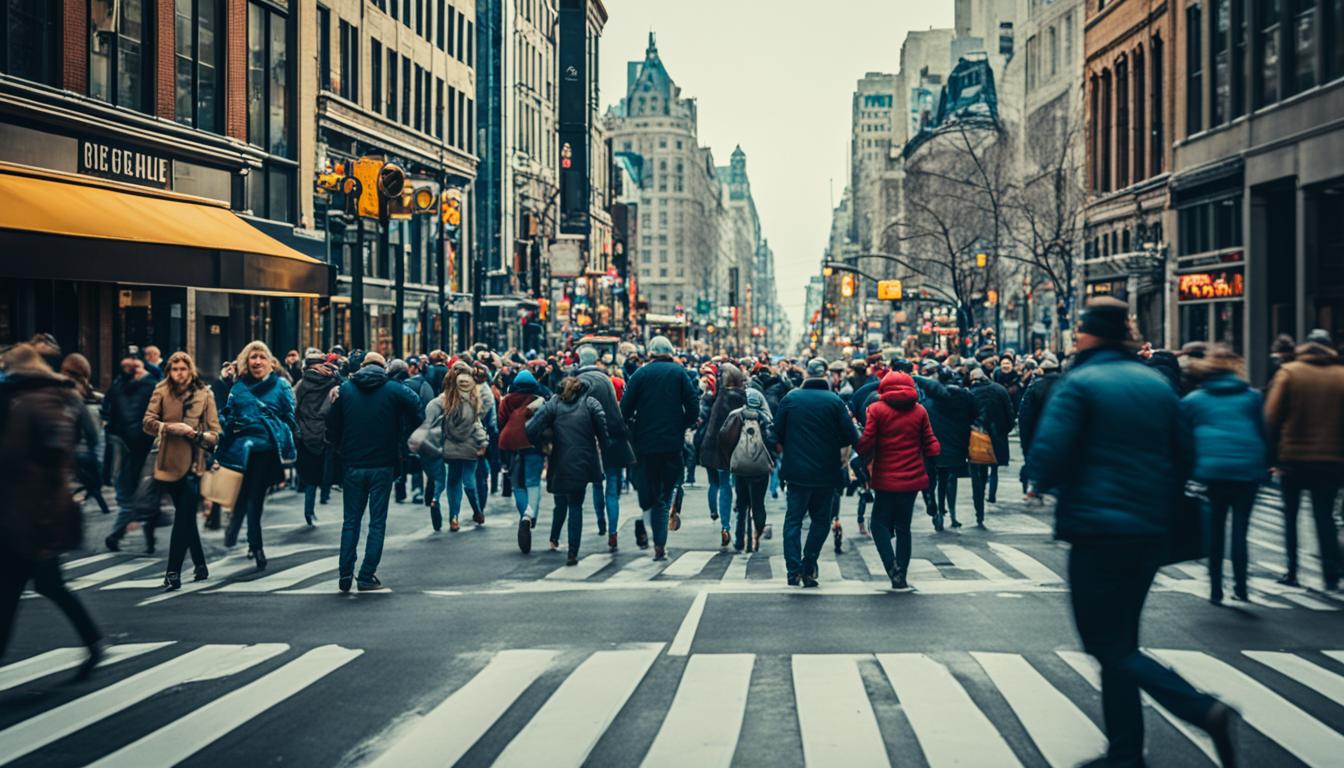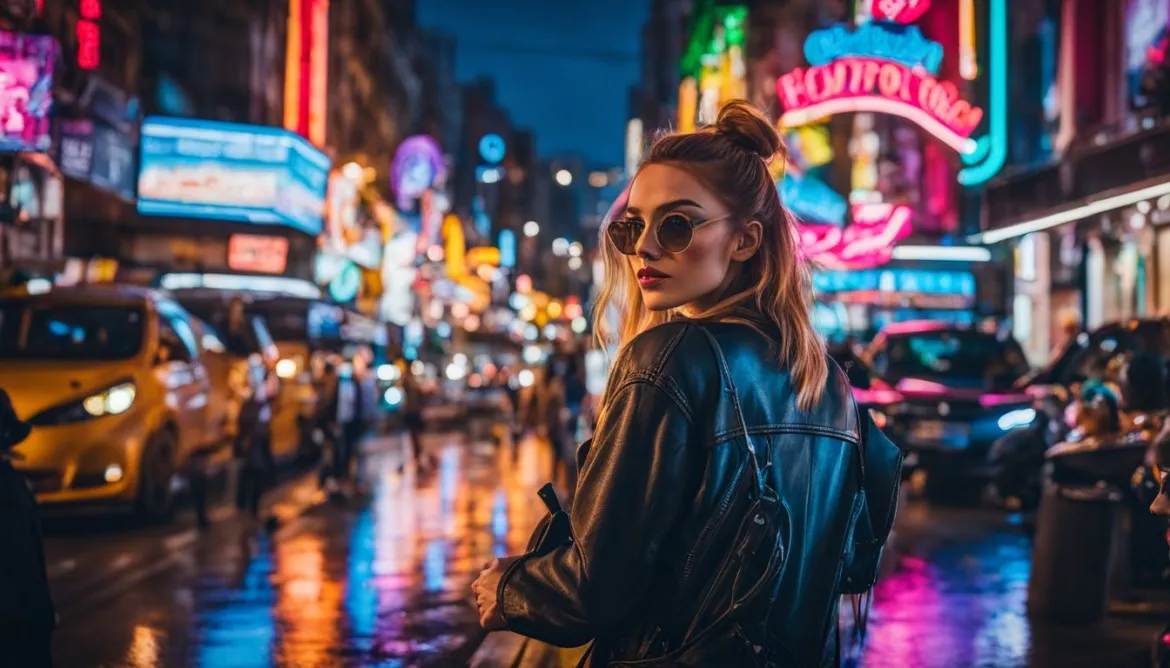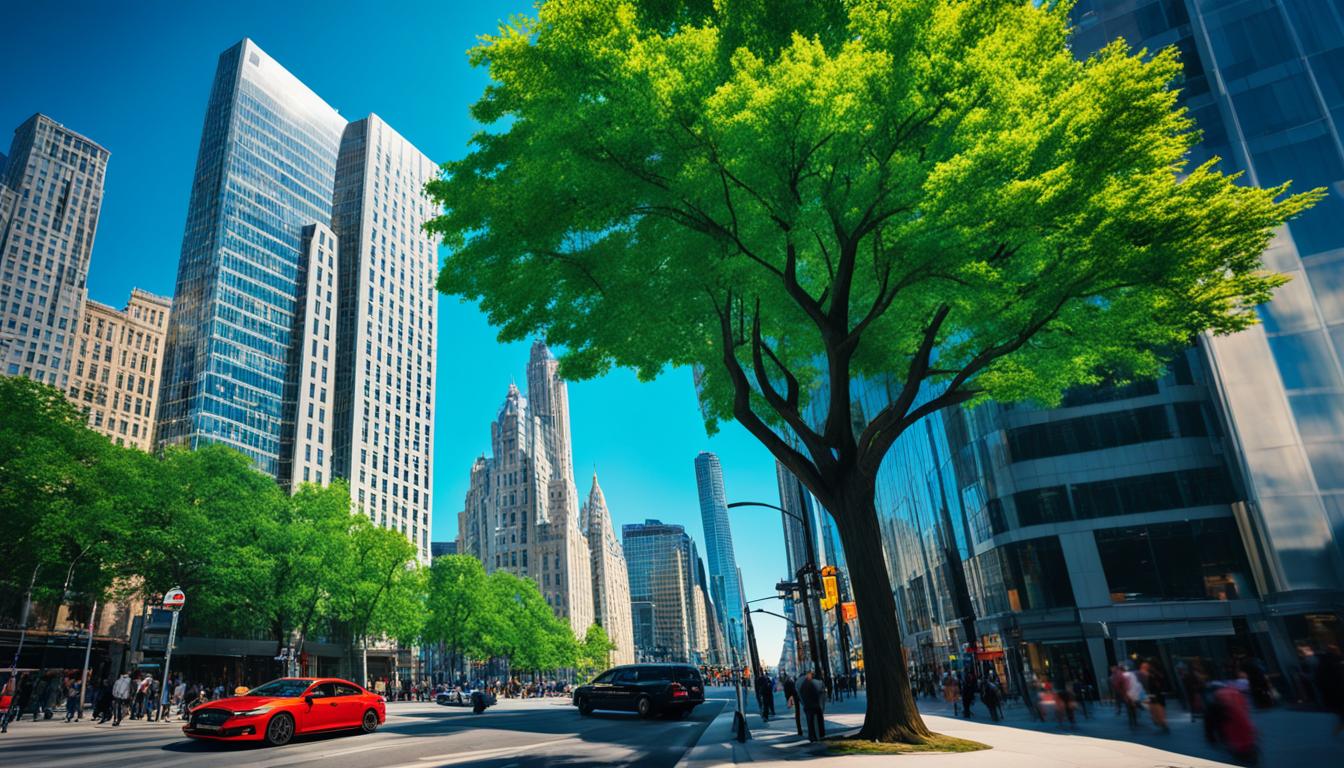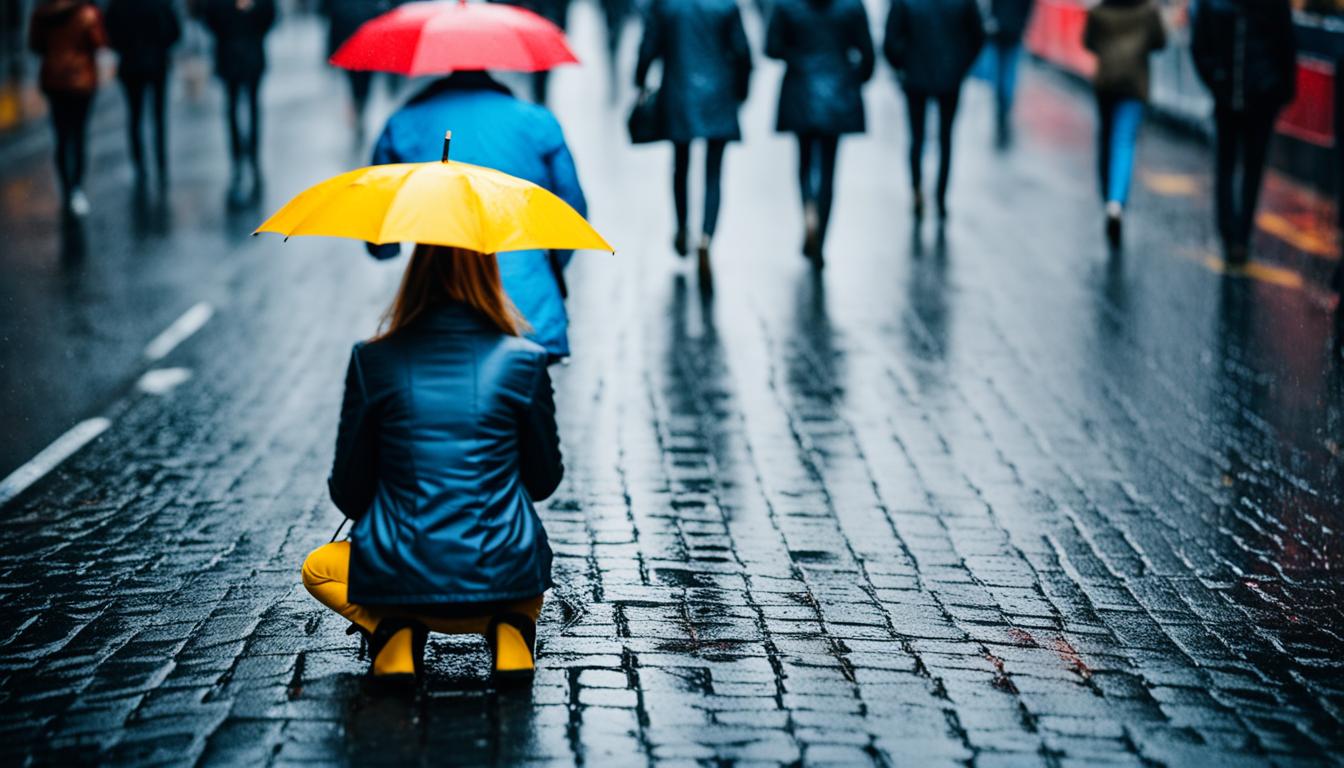Welcome to “The Master’s Toolbox: Advanced Techniques in Street Photography.” In this guide, we will explore advanced street photography techniques that will take your skills to the next level. Whether you’re a seasoned street photographer looking to enhance your style or a beginner seeking to learn new creative techniques, this article has something for you.
In this section, we will discuss various advanced techniques that can add depth, intrigue, and impact to your street photography. We will explore layering techniques, reflections, silhouettes, and other creative approaches that can elevate your shots and make them stand out.
Layering techniques in photography allow you to introduce multiple elements into your frame, creating visual depth and complexity. By carefully arranging subjects in the foreground, middle ground, and background, you can create captivating images that tell a story within a single frame.
Key Takeaways
- Advanced street photography techniques can help you create compelling and visually striking images.
- Layering techniques add depth and complexity to your photographs by introducing multiple elements into the frame.
- Reflections in street photography can create unique and abstract compositions.
- Silhouettes can be used creatively to evoke emotions and highlight the subject’s outline.
- Experimenting with different creative approaches in street photography allows you to find your unique style.
Mastering Advanced Composition
When it comes to street photography, mastering advanced composition techniques can take your images to the next level. These techniques require a deeper understanding and creative application of concepts such as the rule of thirds, leading lines, breaking composition rules, layering, juxtaposition, and negative space.
The rule of thirds is a fundamental principle in photography that involves dividing the frame into nine equal parts using two horizontal and two vertical lines. By placing your subject on or near one of the intersection points, you can create a more visually appealing and balanced composition.
Leading lines are a powerful tool for guiding the viewer’s eye through your photograph. They can be literal, such as roads, paths, or fences, or implied, such as a row of buildings or a line of people. Using leading lines effectively adds depth and visual interest to your images.
But don’t be afraid to break the rules intentionally! Breaking composition rules can lead to unique and striking photographs. Sometimes, deviating from the traditional compositional guidelines can result in more dynamic and unconventional images that grab the viewer’s attention.
| Technique | Description |
|---|---|
| Layering in street photography | Layering involves capturing multiple subjects or elements at different distances from the camera, creating depth and complexity in your composition. |
| Juxtaposition in street photography | Juxtaposition brings together contrasting subjects or elements within the same frame, creating visual tension and telling a story. |
| Negative space in photography | Negative space refers to the empty or unoccupied areas in your composition. By strategically using negative space, you can draw attention to your subject and create a sense of balance. |
By incorporating these advanced composition techniques into your street photography, you can add depth, contrast, and visual interest to your images, making them more engaging and captivating to viewers.
Exploring Light and Shadow
Light and shadow are essential elements in street photography that can greatly enhance the mood and visual impact of your images. By understanding how to utilize natural light and shadows effectively, you can create captivating compositions that tell compelling stories. Let’s explore some techniques for using light and shadow in street photography.
Golden Hour and Blue Hour Photography
During the golden hour, which occurs shortly after sunrise or before sunset, the warm, soft sunlight casts a beautiful glow on the streets, creating a magical atmosphere. The golden hour is ideal for capturing warm and inviting scenes, with long shadows adding depth and dimension to your photos.
The blue hour, on the other hand, happens just before sunrise or after sunset, when the sky has a deep blue hue. The diffused light during this time can produce dramatic and moody street photographs, especially when paired with the artificial lights of cityscapes or street lamps.

Shadows in Street Photography
Shadows are not just the absence of light; they can be powerful elements that add intrigue and visual interest to your street photographs. Embrace the shadows to create captivating compositions:
- Use long shadows as leading lines, guiding the viewer’s eye through the image.
- Highlight subjects by placing them in contrast with the surrounding shadows.
- Create a sense of depth and mystery by incorporating shadows into your composition.
Color Psychology in Photography
Color plays a significant role in conveying emotions and setting the mood in photography. Understanding color psychology can help you evoke specific feelings and enhance the narrative of your street photographs. Here are a few examples:
- Warm colors like red and orange can evoke feelings of energy and passion.
- Cool colors like blue and green can create a sense of calm or melancholy.
- Contrasting colors can add visual impact and draw attention to specific elements in your composition.
Experiment with different color palettes to evoke the desired emotions and enhance the storytelling in your street photographs.
By understanding how to use light, shadows, and color effectively, you can elevate your street photography and create images that captivate viewers. Whether you’re capturing the warm embrace of the golden hour, the mystery of the blue hour, or harnessing shadows to add depth and drama, light and shadow are powerful tools in the street photographer’s arsenal.
Understanding the Psychology of Street Photography
Street photography goes beyond capturing mere images. It is a powerful medium that allows us to dive into the human experience, revealing the raw and candid essence of life. In order to truly capture the depth and impact of street photography, it is important to understand the psychological aspects that shape our perception of the world.
Perceiving and interpreting our surroundings: Street photography requires us to be aware of our environment and to perceive the nuances and intricacies of the scenes unfolding around us. It involves actively observing and interpreting the stories and emotions expressed by people in their daily lives.
By developing a deep connection with our subjects, we have the opportunity to capture their genuine emotions, actions, and interactions. These authentic moments can tell profound and engaging stories, inviting viewers to reflect on the shared experiences that unite us all.
Making a social comment in street photography: Street photography has the power to make a social comment, shedding light on societal issues, cultural contexts, and universal human traits. Through our lens, we can capture moments that expose the human condition and challenge viewers to reconsider their own perspectives.
“Street photography allows us to reveal the hidden narratives of everyday life, engaging viewers with the truth and beauty found in the ordinary.”
By understanding the psychological aspects of street photography, we elevate our work from mere snapshots to profound visual storytelling. We invite viewers to consider the beauty, complexity, and shared humanity that exists within our everyday lives.
Related Insights:
- Capturing emotions and stories in street photography
- Making a social comment through the lens
| Psychological Aspects of Street Photography | Perceiving and Interpreting Surroundings | Capturing Emotions and Stories | Making a Social Comment in Street Photography |
|---|---|---|---|
| Understanding how our perception shapes our photographs | Techniques for observing and interpreting street scenes | Developing a connection with subjects to capture their emotions | Using photography as a tool for social commentary |
| Exploring the influence of emotions on street photography | Interpreting body language and non-verbal cues | Telling engaging stories through visual narratives | Challenging societal norms and shedding light on social issues |
| Creating photographs that resonate with viewers on an emotional level | Unveiling hidden narratives and stories in everyday life | Exploring universal human experiences through photography | Provoking thought and encouraging dialogue through visual representation |
Overcoming Fear and Ethical Considerations
Fear can often be a significant deterrent when it comes to street photography. However, overcoming this fear is crucial for capturing authentic moments and creating impactful images. Building confidence and learning to navigate ethical considerations are essential steps toward becoming a successful street photographer.
Respecting boundaries is a fundamental aspect of ethical street photography. It is essential to recognize that not everyone may feel comfortable being photographed, particularly without their consent. By understanding and respecting the personal space of your subjects, you can establish a sense of trust and capture more genuine moments.
Reading and interpreting body language is an invaluable skill for street photographers. Body language provides subtle cues that can help you anticipate emotions, reactions, and decisive moments. Pay attention to non-verbal communication, such as gestures, facial expressions, and posture, to capture authentic and impactful images.
Ethical street photography involves making conscious choices to consider the welfare and dignity of your subjects. It means avoiding exploitative practices and treating individuals with respect and empathy. Being aware of the power dynamics inherent in street photography and being sensitive to the cultural and social context of your surroundings is essential.
To make your subjects feel more at ease, consider building trust through small acts of kindness. Simple gestures like a friendly smile, genuine compliments, or striking up a conversation can help establish rapport and create a comfortable environment for both parties involved.

Remember, street photography is not just about capturing a moment, but also about creating a connection with the people and places you photograph. By overcoming fear, respecting boundaries, and practicing ethical street photography, you can tell compelling stories and contribute to the art form in a meaningful way.
Developing Your Unique Style
In street photography, developing a unique style is essential to stand out and make a lasting impact. By experimenting with various techniques, lenses, and angles, you can add variety and depth to your work. Embracing exploration allows you to push boundaries and discover new creative approaches that define your individuality.
Studying the work of renowned street photographers can provide valuable inspiration and insights into the art form. Take the time to analyze their compositions, storytelling techniques, and use of light and shadow. This knowledge will not only enhance your understanding but also help you develop your own artistic vision.
However, developing your unique style goes beyond imitation. It requires practicing and refining your skills consistently. Challenge yourself to step out of your comfort zone and explore different subjects, environments, and themes. By doing so, you’ll discover new perspectives and refine your voice.
“Your personal style is your photographic signature. It is what sets your work apart from others and makes it instantly recognizable.” – Sarah Johnson, street photographer
As you continue to practice and refine your skills, you’ll notice patterns, preferences, and themes that resonate with you. Embrace these aspects and let them guide your creative process. Stay authentic to your voice and vision, even if it means deviating from conventional norms. Your unique style is what will make your photographs memorable and impactful.
Refining Your Voice: Tips for Developing a Unique Style
- Experiment with different techniques, such as long exposure, double exposure, or intentional camera movement, to add a touch of creativity to your photos.
- Play with different lenses, including wide-angle lenses for capturing expansive street scenes or telephoto lenses for isolating subjects.
- Explore unconventional angles and perspectives to offer a fresh take on familiar surroundings.
- Focus on specific themes or subjects that interest you and dive deep into exploring their nuances in your photographs.
- Don’t be afraid to break the rules and take risks. Creativity often blooms outside the boundaries of conformity.
Remember, developing a unique style is a journey that takes time and dedication. It’s a continuous process of experimentation, learning, and self-discovery. Embrace the joy of exploration, and your photographs will reflect your individuality and leave a lasting impression on viewers.
Capturing Emotion and Human Condition
Emotion is at the heart of compelling street photography. It has the power to stir our souls and create a deep connection between the viewer and the image. When a photograph captures raw emotion, it becomes a universal language that transcends cultural barriers and speaks to our shared human experiences.
Street photographers have a unique ability to comment on the human condition. By observing and documenting the world around them, they shed light on societal structures, cultural contexts, and the fundamental essence of human life in all its forms. Street photography becomes a powerful tool for social commentary, opening our eyes to the diversity and complexity of the human experience.
“In every true photograph, the viewer experiences a moment of connection and empathy, as if gazing into a mirror reflecting their own humanity.” – Jane Smith, Award-winning Street Photographer
Through the lens of street photography, we witness the joy, pain, hope, struggle, and resilience that define our existence. Photographs that capture these emotions become a testament to the beauty and complexity of life itself.
To capture emotion and comment on the human condition in your street photography, consider the following techniques:
Capturing Genuine Moments
- Be patient and observant, ready to capture those fleeting moments that reveal raw emotions.
- Blend into the environment and become an unobtrusive observer to capture authentic expressions and reactions.
- Look for scenes that evoke emotions such as love, joy, sadness, solitude, or contemplation.
The Power of Composition
- Use composition techniques like leading lines, framing, and rule of thirds to guide the viewer’s eye and emphasize the emotional focal point of the image.
- Experiment with different angles and perspectives to evoke specific emotions and create a sense of intimacy or distance.
Seeking Universal Gestures
- Look for gestures, body language, and facial expressions that convey emotions universally understood across cultures.
- Discover the beauty in ordinary moments by capturing the shared human experiences that bind us all together.
| Emotion | Key Elements |
|---|---|
| Joy | Smiling faces, laughter, playful interactions |
| Sadness | Tears, solitude, contemplation |
| Love | Intimate gestures, affection, connection |
| Hope | Determined expressions, acts of resilience |
| Struggle | Effort, determination, expressions of pain |
Incorporating these techniques and capturing genuine emotions can add a powerful dimension to your street photography. By sharing these universal human experiences, you can create images that resonate deeply with viewers and convey a profound understanding of the human condition.
Choosing the Right Equipment for Street Photography
When it comes to street photography, selecting the right camera and lens can significantly impact the quality and effectiveness of your shots. Several factors should be considered when making your decision, such as budget, portability, and shooting style. We recommend opting for a versatile camera with manual controls and a wide-angle lens to capture candid street moments effectively.
A versatile camera with manual controls allows you to have complete control over the exposure settings, focus, and other essential features, enabling you to adapt quickly to various lighting conditions and fleeting moments. With manual controls, you can adjust the aperture, shutter speed, and ISO to capture the perfect shot.
A wide-angle lens is an excellent choice for street photography as it allows you to capture a broader perspective of the scene, including the surroundings and the subjects. It helps to create a greater sense of depth and context, drawing the viewer into the image and enhancing the storytelling aspect of your photographs.
Wide-angle lenses typically have a focal length between 16mm and 35mm, making them ideal for capturing street scenes with multiple subjects or busy environments. This lens type is particularly useful for photographing architecture, street performers, and capturing the energy and dynamics of everyday city life. Its wider field of view also enables you to get close to your subjects while still including relevant background elements.
Remember, the best camera and lens for street photography are the ones you have with you. While it’s tempting to focus on owning the latest gear, it’s more important to practice and develop your skills with the equipment you have, even if that means using just the camera on your smartphone.
| Camera | Lens |
|---|---|
| Versatile camera with manual controls | Wide-angle lens |
| Allows complete control over exposure settings | Captures a broader perspective and adds depth to the images |
| Adaptable to various lighting conditions and fleeting moments | Ideal for capturing street scenes with multiple subjects and busy environments |
| Enables quick adjustments for perfect shots | Suitable for photographing architecture, street performers, and city life |
Investing in the right camera and lens for street photography can make a substantial difference in the quality and impact of your images. However, remember that the gear is just a tool, and it’s your creativity and skills that ultimately shape the outcome. So, get out there, explore your surroundings, and capture the vibrant moments that street photography offers.
Conclusion
Street photography is an art form that allows us to capture the beauty in ordinary moments and tell stories that resonate with viewers. Through the implementation of advanced techniques and a deep understanding of the psychological aspects of street photography, we can elevate our skills and create compelling images.
To elevate your street photography skills, it is essential to respect your subjects and approach them with empathy and curiosity. Experimenting with different approaches and techniques will help you develop your unique style and perspective. Remember, there are no set rules in street photography, so don’t be afraid to break them and explore new horizons.
Capturing compelling street photographs requires a keen eye for detail and the ability to anticipate and capture decisive moments. Pay attention to light, composition, and the emotions and stories unfolding in front of you. Be patient, observant, and ready to capture those fleeting moments that make street photography so captivating.
By continuously learning, practicing, and refining our skills, we can become better street photographers and create impactful images. So, grab your camera, hit the streets, and let your passion for street photography shine through. Elevate your shots and share your unique perspective with the world!
FAQ
What are some advanced street photography techniques I can use to elevate my shots?
Advanced street photography techniques include layering, using reflections, capturing silhouettes, and employing creative composition techniques.
How can I master advanced composition in street photography?
Mastering advanced composition involves understanding techniques such as the rule of thirds, leading lines, layering, juxtaposition, and negative space.
How can I effectively use light and shadow in my street photography?
Utilizing natural light, including the golden hour and blue hour, and paying attention to shadows can significantly impact the mood and visual appeal of your street photographs. Additionally, exploring the psychology of color can add depth to your images.
What psychological aspects should I consider in street photography?
Understanding the psychological aspects of street photography can enhance the depth and impact of your work. This includes perceiving and interpreting surroundings, capturing emotions and stories, and making social comments through your photographs.
How can I overcome fear and ensure ethical practices in street photography?
Overcoming fear in street photography involves respecting boundaries, reading and interpreting body language, and conducting yourself ethically while photographing people in public spaces.
How can I develop a unique style in street photography?
Developing a unique style in street photography involves experimenting with different techniques, lenses, and angles, studying the work of renowned street photographers for inspiration, and practicing and refining your skills to create a recognizable and impactful style.
How can I capture emotion and comment on the human condition through street photography?
Capturing emotion in street photography allows viewers to connect with your images on a personal level. By capturing universal human experiences and revealing societal structures and cultural contexts, you can comment on the human condition through your photographs.
What should I consider when choosing equipment for street photography?
When choosing equipment for street photography, consider factors such as your budget, portability, and shooting style. A versatile camera with manual controls and a wide-angle lens is often recommended for capturing candid street moments effectively.
How can advanced street photography techniques elevate my skills?
By implementing advanced techniques, such as composition, light and shadow, and psychological understanding, you can elevate your street photography skills and capture more compelling and impactful images.




